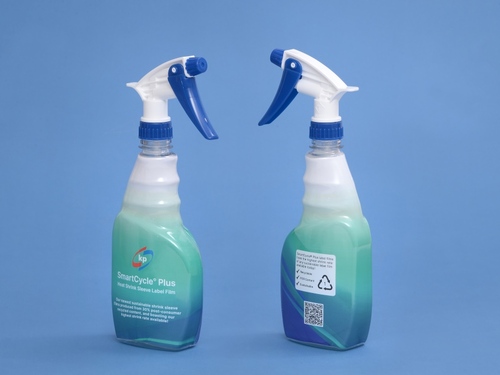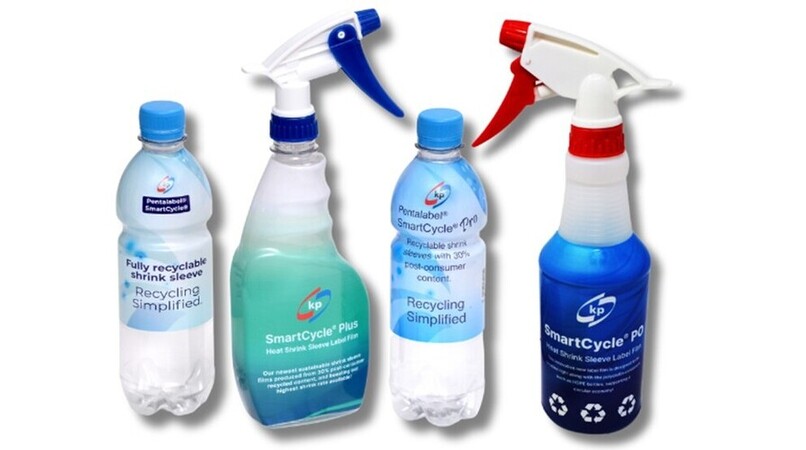Rethinking shrink sleeves: how recycled content is reshaping sustainable packaging
Industry insights, innovation highlights, and expert perspectives on the growing role of recycled content in shrink sleeve applications.
Shrink sleeve packaging has long been a go-to for brands seeking shelf appeal, versatility, and full-body design impact. But as the packaging industry confronts mounting sustainability challenges, shrink sleeves are being re-evaluated through a new lens: circularity.
Shrink sleeve packaging has long been a go-to for brands seeking shelf appeal, versatility, and full-body design impact. But as the packaging industry confronts mounting sustainability challenges, shrink sleeves are being re-evaluated through a new lens: circularity.
Today, the conversation is shifting from “can we make it recyclable?” to also “can we make it from something recycled?”. In that spirit, integrating recycled content into shrink sleeve applications isn’t just an illusion; kp makes it possible and reduces the overall virgin material being used.
Share this story
“Recycled content is no longer a value-add. It’s fast becoming a baseline expectation from retailers, regulators, and consumers.”
Laurent Foldès
Global Market Development Manager, Labels
1. The case for recycled content in shrink sleeves
Why the urgency? Pressure is coming from multiple directions. Governments are introducing recycled content mandates. Retailers are establishing stringent packaging scorecards. And consumers increasingly equate packaging materials with brand values.
Shrink sleeves, while effective in design and function, have traditionally relied on 100% virgin plastics. Moving toward post-consumer recycled (PCR) content offers a way to align with environmental targets - without compromising branding.
At the same time, the industry is facing increasing calls to phase out challenging materials, such as PVC and PETg, due to their incompatibility with common recycling streams. There’s also a strong push toward mono-material packaging and harmonised recyclability guidelines, helping to simplify the recovery and reuse of packaging components. Frameworks like the European PET Bottle Platform (EPBP) or RecyClass are gaining influence, providing recyclability endorsements that are now guiding packaging development and brand owner decisions.
It’s not just about compliance. Brands that lead on recycled content gain a competitive advantage, showcasing commitment to environmental responsibility in a very visible way.
Shrink sleeves, while effective in design and function, have traditionally relied on 100% virgin plastics. Moving toward post-consumer recycled (PCR) content offers a way to align with environmental targets - without compromising branding.
At the same time, the industry is facing increasing calls to phase out challenging materials, such as PVC and PETg, due to their incompatibility with common recycling streams. There’s also a strong push toward mono-material packaging and harmonised recyclability guidelines, helping to simplify the recovery and reuse of packaging components. Frameworks like the European PET Bottle Platform (EPBP) or RecyClass are gaining influence, providing recyclability endorsements that are now guiding packaging development and brand owner decisions.
It’s not just about compliance. Brands that lead on recycled content gain a competitive advantage, showcasing commitment to environmental responsibility in a very visible way.
2. Technical challenges - and how we’re solving them
Transitioning to recycled content in shrink sleeves comes with unique technical complexities that require careful material science and processing adjustments.
- Clarity & aesthetics: Maintaining high optical quality with PCR can be tricky. Minor impurities can impact transparency or print performance.
- Shrink performance: recycled resins can behave unpredictably during shrink, impacting label conformity and shelf appeal.
- Print compatibility: Ink adhesion and colour consistency can vary depending on the material source.
“Achieving premium shrink performance with recycled resin is a fine balance. But with the right formulation and processing, we’re getting very close to parity with virgin materials.”
Laurent Foldès
Global Market Development Manager, Labels
Innovation is catching up. Advances in material sorting, purification, and film extrusion are making high-performance recycled shrink films a commercial reality. To help meet this demand, we offer the SmartCycle® family of sustainable heat shrink sleeve films. These films are designed with recyclability in mind.
3. From niche to norm: What the market is saying
Just a few years ago, PCR-based shrink sleeves didn’t make sense as shrink sleeves were not considered as recyclable. Today, they’re showing up in RFQs from some of the world’s biggest brands. We get questions like “Will this sleeve compromise bottle recyclability? What solutions will be endorsed by the Packaging and Packaging Waste Regulation (PPWR)?”
Brand owners aren’t just requesting PCR—they need transparency, traceability, and third-party certifications (e.g., ISCC, FDA-compliant PCR).
Industries leading the adoption include:
Brand owners aren’t just requesting PCR—they need transparency, traceability, and third-party certifications (e.g., ISCC, FDA-compliant PCR).
Industries leading the adoption include:
- Personal care & cosmetics, where sustainable branding is central.
- Beverage and functional drinks, where full-body sleeves dominate.
- Household products, seeking cost-effective ways to meet ESG goals.
“We’re seeing clients ask: ‘How much PCR can you guarantee—and can you prove where it comes from?’ That’s where traceable supply chains become critical.”
Laurent Foldès
Global Market Development Manager, Labels
4. Designing for circularity

Key considerations:
- Material selection: choosing polymers compatible with bottle recycling (e.g., PETG vs. OPS).
- Perforation features: Enabling easy separation of sleeve from bottle.
- Inks and coatings: Using de-inkable systems that don’t contaminate recycling streams.
“To be part of a circular system, a shrink sleeve has to do two things: be easy to recycle and use recycled content again. That’s the new bar.”
— Laurent Foldès, Global Market Development Manager, Labels
There are also emerging efforts around closed-loop systems, where shrink sleeve material is recovered, recycled, and reintroduced into new film applications - creating a truly regenerative cycle.
5. Looking ahead: what’s next?
The path to more sustainable shrink sleeve packaging is still evolving—but the momentum is unmistakable.
Here’s what we expect to see in the next 3–5 years:
Here’s what we expect to see in the next 3–5 years:
- Wider availability of high-clarity PCR shrink films
- Adoption of mono-material sleeves compatible with HDPE and PET recycling
- Increased regulation requiring minimum PCR content levels
- Stronger consumer labeling showing recycled content usage (e.g., “30% post-consumer content”)
“We’re not just replacing virgin plastic - we’re rethinking how shrink sleeves contribute to the circular economy. The future isn’t about compromise - it’s about innovation.”
Laurent Foldès
Global Market Development Manager, Labels
Final thoughts: leading with purpose
Using recycled content in shrink sleeves is about more than ticking a box. It’s a strategic, environmental, and brand decision. For converters, it means investing in capabilities and partnerships. For brand owners, it means leading with purpose and setting new standards.
“Using recycled content provides significant environmental benefits by reducing the use of virgin materials, supporting recycling markets, and lowering emissions.”
— Laurent Foldès, Global Market Development Manager, Labels
The takeaway? This shift isn’t optional - it’s an opportunity. And those who embrace it early will help define the next generation of packaging.
📌 Want to learn more?
Our team is actively working on new, recycled content shrink sleeve solutions. Let’s talk about how we can help your brand move forward, sustainably.
— Laurent Foldès, Global Market Development Manager, Labels
The takeaway? This shift isn’t optional - it’s an opportunity. And those who embrace it early will help define the next generation of packaging.
📌 Want to learn more?
Our team is actively working on new, recycled content shrink sleeve solutions. Let’s talk about how we can help your brand move forward, sustainably.
About Laurent Foldès, Global Market Development Manager, Labels:

Laurent holds a French engineering degree. He is driving the brand management development programme for the label division at Klöckner Pentaplast. Laurent previously spent 15 years in the automotive industry before joining the packaging and label world.
Laurent is leading the global cPET consortium and co-chairing the label working group at Petcore Europe.
He lives in Saint Germain en Laye in France, with his wife and their three children. In his free time, Laurent likes to do trail running, play golf or coach rugby for his son’s team.
Laurent is leading the global cPET consortium and co-chairing the label working group at Petcore Europe.
He lives in Saint Germain en Laye in France, with his wife and their three children. In his free time, Laurent likes to do trail running, play golf or coach rugby for his son’s team.
More like this








